Clothing
What do these photos tell you about the clothes these people wore?
Childrens' Clothing
The Ute Indian children in this photo are wearing traditional items of clothing. The dress of the girl in front is made of deer skin fringed at the bottom. The boy at the right is wearing a fringed leather shirt or jacket. The boy with the feathers in his hair is wearing a chest plate made of bones. All are wearing deerskin moccasins.
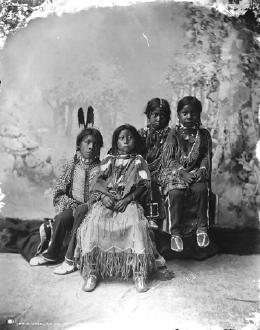
Photo: Colorado Historical Society
More About This Topic
These were the children of Severo, a chief of the Capota band of Utes. He was one of the Ute chiefs who went to Washington D. C. in 1880 to sign a peace treaty.
Ute Buckskin Dress
This is a Ute dress made of buckskin. The upper part of the dress is decorated with animals and designs made of colored beads. The sleeves and the bottom have buckskin fringes. This dress belonged to the wife of Ignacio, a Ute chief. Her name was Lauriano-I-You.
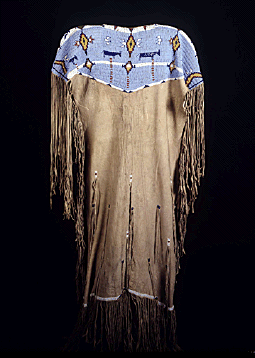
Photo: Colorado Historical Society
More About This Topic
Indian women used animal skins to make their dresses. A dress like the one in the photo used two or three deer skins.
Their Own Words
"The women’s finest costume was a fringed buckskin skirt, smoked or white, cut straight and long, and a straight buckskin jacket. These were trimmed in several ways: with rows of elks' teeth, with beaded or painted designs, or with strings of beads or jingles added to the fringe."
Source: Althea Bass, The Arapaho Way: A Memoir of an Indian Boyhood [by Carl Sweezy] (New York: Clarkson N. Potter, Inc., 1966), p. 36.
Ute Buckskin Shirt
This photo shows the back of a Ute shirt. It was made from the skin of a buck or male deer. It is decorated with colored beads sewn to a white background and by a buckskin fringe. The shirt belonged to Ouray, a Ute chief.
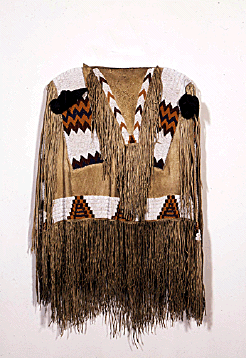
Photo: Colorado Historical Society
More About This Topic
Men wore shirts during the winter to help them keep warm. During the summer, men wore only a breech cloth made of hide.
Indian Child's Dress
This dress was made for an Indian child, probably an Arapaho child. It is made of deerskin. The top is decorated with colored beads. It has a leather fringe on the sleeves, down the sides, and at the bottom.
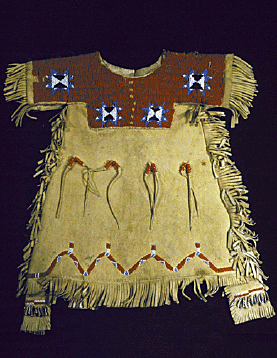
Photo: Colorado Historical Society
Ute Moccasins
This is a pair of Ute moccasins. They are made of buckskin stitched to a rawhide sole. The ties also are rawhide. They are embroidered on top with designs made of colored glass beads.
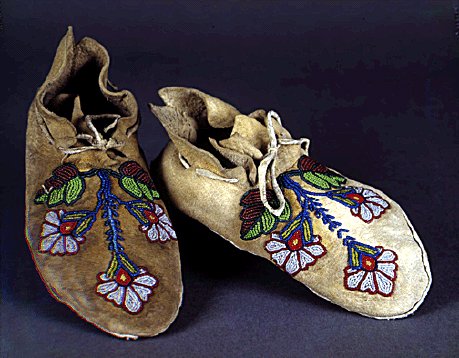
Photo: Colorado Historical Society
More About This Topic
Moccasins were very practical. The rawhide soles could be replaced when they wore out. Winter moccasins had a loose piece of leather that was drawn around the ankle and tied to keep out snow. Decorating moccasins and other clothing was a form of Indian art.
Their Own Words
"When the women were not busy with other things, they had handwork to do. The Cheyenne and the Arapaho women made the finest of moccasins. Whether they were made of strong, smoked elk skin or of soft, dressed buckskin, they always fitted the feet they were made for, and were decorated in designs that suited the line of the foot."
Source: Althea Bass, The Arapaho Way: A Memoir of an Indian Boyhood [by Carl Sweezy] (New York: Clarkson N. Potter, Inc., 1966), p. 29.
Buffalo Robe
This is a robe made from the hide of a buffalo bull. Buffalo robes were used as bed covers in the winter and as warm wraps to wear outdoors. The bare hide shown in this photo is decorated with painted designs. The hair side of the robe is against the wall.
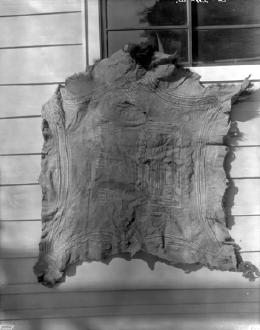
Photo: Denver Public Library, Western History Collection
More About This Topic
Buffalo provided Indians with clothing to wear as well as meat to eat. They used the soft hides of buffalo cows and calves to make clothing. The hide of the buffalo bulls was heavier and thicker. They used it to make robes like the one in this photo and tipi coverings.When buffalo were scarce, they made robes of rabbit, coyote, and wolf skins.
Their Own Words
"As long as the buffalo roamed the plains, it supplied us with nearly everything we needed. . . We had never wasted any part of the animal when we killed it: its hide made our lodge coverings, robes for our beds, and for clothing, and shields and parfleches; its paunch made pails and bowls; its tail and hooves made ornaments; its horns made spoons and tools; its sinews made stout cords. . . ."
Ute Blankets
This photo of a Ute woman shows some of the ways that Colorado Indians used blankets. She is wearing a very fine blanket as a cape. Behind her are colorful blankets used to decorate the wall. She is standing on a blanket used as a rug. This woman also is wearing a decorative belt and is holding a beaded pouch in her left hand.
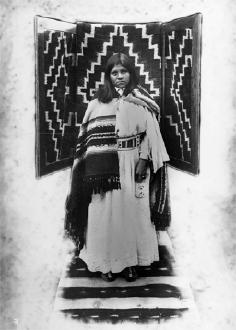
Photo: Denver Public Library, Western History Collection
More About This Topic
As buffalo became scarce, Colorado Indians used blankets as robes and bed covers. The blankets came from Mexico and from the Navaho Indians in Arizona. The Indians of Colorado got these blankets through trade.

